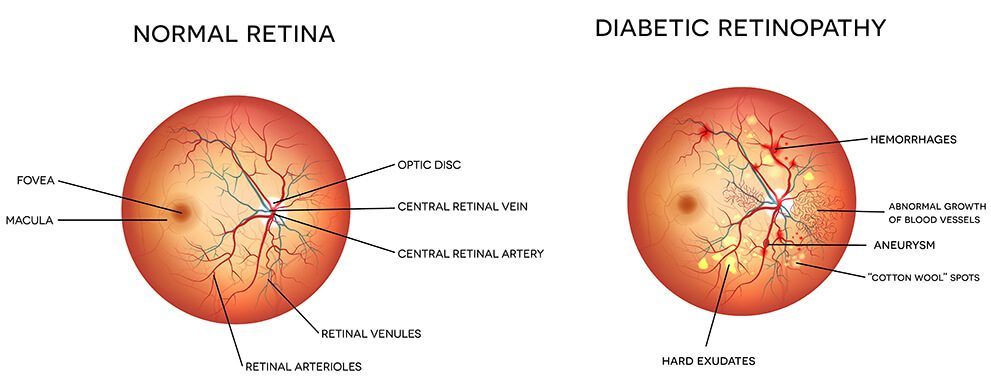Diabetic retinopathy is the most common diabetic eye disease. It consists of damage to the blood vessels in the retina and can cause vision impairment or blindness.

Risk Factors
All people with diabetes are at risk, including Type I (juvenile onset) and Type II diabetes. During pregnancy, diabetic retinopathy may also be a problem for women with diabetes. All pregnant women with diabetes should have dilated eye examinations each trimester to protect their vision.
About 50 percent of people with diabetes will develop diabetic retinopathy during their lifetime.
Prevalence
About 50 percent of people with diabetes will develop diabetic retinopathy during their lifetime. The longer a person has diabetes, the higher the risk to develop diabetic retinopathy.
Vitreous floaters are sometimes seen as threadlike strands in the patient’s visual field. Typically these lines/spots float or drift as the eye moves
Symptoms
Floaters can be a sign of diabetic retinopathy. Sometimes difficulty reading or doing close work can indicate that fluid is collecting in the macula, the most light-sensitive part of the retina.
Treatment
Two treatment options are available; both of which are very effective but do not cure diabetic retinopathy: Laser surgery is performed in a doctor’s office or eye clinic. Before the surgery, your ophthalmologist will dilate your pupil and apply drops to numb the eye. In some cases, the doctor also may numb the area behind the eye to prevent any discomfort. A vitrectomy will be performed whenever laser surgery is deemed inefficient, usually if you have a lot of blood in the vitreous. A vitrectomy involves removing the cloudy vitreous and replacing it with a salt solution. Because the vitreous is mostly composed of water, you won’t notice the difference between the salt solution and the normal vitreous.



The holiday season is full of sparkle—but a few festive favorites can put your eyes at risk. 1. Champagne Corks 🥂 Celebratory toasts can turn dangerous fast. A champagne cork can launch up to 50 mph, causing serious eye injuries. 2. Sharp Tree Branches & Pine Needles 🎄
Decorating the tree often means leaning in close—and those stiff branches can scratch the eye’s surface, leading to painful corneal abrasions. 3. Flying Toys & Projectiles 🎯
Nerf guns, darts, drones, and remote-control gadgets are holiday favorites—but also common causes of eye injuries in ERs every December. 4. Glitter, Craft Supplies & DIY Décor ✨
Holiday crafts are fun, but glitter, adhesives, and decorative sprays can irritate the eyes or cause chemical injuries. 5. Dry Winter Air & Holiday Travel ✈️❄️
Heaters, cold air, and long flights can leave eyes dry, red, and irritated—especially for contact lens wearers.
Take care of your eyes this season! ... See MoreSee Less
0 CommentsComment on Facebook
We appreciate our teams and our highly trained doctors who are available to see patients quickly for urgent needs. Your eyes are precious, we are here to help!
#TestimonialTuesday ... See MoreSee Less
0 CommentsComment on Facebook
Hau'oli Lā Ho'omaika'i! ... See MoreSee Less
0 CommentsComment on Facebook
Mahalo to our community and our patients for making our offices across the islands feel more like an o'hana. ... See MoreSee Less
0 CommentsComment on Facebook
We use state-of-the-art retinal imaging and OCT technology to catch even the smallest changes in your eye health—often before symptoms appear. Because your sight deserves precision. Eye Center of Hawaii is your place for your retina care! ... See MoreSee Less
0 CommentsComment on Facebook
Healthy can be delicious! 🎃 Try this eye-friendly pumpkin mousse that’s packed with nutrients to support your vision while satisfying your sweet tooth.
Let us know if you give it a try, we’d love to hear what you think! 👇 ... See MoreSee Less
0 CommentsComment on Facebook